Effects of sowing date and ecological points on yield and the temperature and radiation resources of semi-winter wheat
2023-05-08ZHANGZhenzhenCHENGShuangFANPengZHOUNianbingXlNGZhipengHUYajieXUFangfuGUOBaoweiWElHaiyanZHANGHongcheng
ZHANG Zhen-zhen, CHENG Shuang, FAN Peng, ZHOU Nian-bing, XlNG Zhi-peng, HU Ya-jie, XU Fangfu, GUO Bao-wei, WEl Hai-yan, ZHANG Hong-cheng
Jiangsu Key Laboratory of Crop Cultivation and Physiology/Innovation Center of Rice Cultivation Technology in Yangtze Valley, Ministry of Agriculture and Rural Affairs/Co-Innovation Center for Modern Production Technology of Grain Crops, Yangzhou University, Yangzhou 225009, P.R.China
Abstract Exploring the effects of sowing date and ecological points on the yield of semi-winter wheat is of great significance.This study aims to reveal the effects of sowing date and ecological points on the climate resources associated with wheat yield in the Rice–Wheat Rotation System.With six sowing dates, the experiments were carried out in Donghai and Jianhu counties, Jiangsu Province, China using two semi-winter wheat varieties as the objects of this study.The basic seedlings of the first sowing date (S1) were planted at 300×104 plants ha−1, which was increased by 10% for each of the delayed sowing dates (S2–S6).The results showed that the delay of sowing date decreased the number of days, the effective accumulated temperature and the cumulative solar radiation in the whole growth period.The yields of S1 were higher than those of S2 to S6 by 0.22–0.31, 0.5–0.78, 0.86–0.98, 1.14–1.38, and 1.36–1.59 t ha–1, respectively.For a given sowing date, the growth days increased as the ecological point was moved north, while both mean daily temperature and effective accumulative temperature decreased, but the cumulative radiation increased.As a result, the yields at Donghai County were 0.01–0.39 t ha–1 lower than those of Jianhu County for the six sowing dates.The effective accumulative temperature and cumulative radiation both had significant positive correlations with yield.The average temperature was significantly negatively correlated with the yield.The decrease in grain yield was mainly due to the declines in grains per spike and 1 000-grain weight caused by the increase in the daily temperature and the decrease in the effective accumulative temperature.
Keywords: wheat yield, sowing date, ecological point
1.lntroduction
Wheat is the most widely grown food crop in the world (Xuet al.2018).As a major wheat producing country, the safe production of wheat in China is closely related to the grain balance of the world (Luoet al.2019).The Huai River and the Yangtze River basins are important wheat growing areas in China, where rice and wheat are the main crops.In situations where the rice–wheat double cropping system dominates, the planting system and planting mode of rice have an impact on wheat planting (Lvet al.2013).
Jiangsu Province spans the lower reaches of the Yangtze River and the Huai River basins.Since the 1990s, Jiangsu has made the decision to vigorously adjust the agricultural planting structure.The project of replacingindicarice withjaponicarice was implemented, bringing about the rapid expansion of the area ofjaponicarice (Zhanget al.2013; Bianet al.2021).Compared withindicarice, the longer growth period ofjaponicarice leads to the postponement of the wheat sowing date (Fenget al.2017); accordingly, the wheat sowing date often approaches the suitable sowing date or occurs later.With the development and application of mechanized high-yield cultivation techniques in recent years, the mechanical transplanting of rice and direct seeding have been adopted, which results in later harvests than traditional manual transplanting (Chenget al.2005; Konget al.2014).As a result, this leads to the late sowing of semiwinter wheat and a significant decrease in the area of suitable sowing time.Late sowing of wheat has become a common phenomenon in the Rice–Wheat Rotation System of Jiangsu Province.
The growth days decrease and the growth period of wheat is postponed with the delay in the sowing date (Ahmed and Fayyaz-ul-Hassan 2015; Zhenget al.2015).In addition, the growth periods of different ecological points vary.The growth period of ecological points at high latitudes is later than that at low latitudes, and the number of days of the whole growth period is greater (Zhaoet al.2005).The growth period of wheat is significantly affected by the combined action of sowing date and ecological points (Lanet al.2005).The corresponding growth temperature and radiation change at different growth periods as the growth period changes (Xu2016; Zhaoet al.2019).When the whole growth period is shortened, the decrease in effective accumulative temperature affects the yield of wheat (LiYet al.2015).That study found that the mean daily temperature suitable for sowing is 16–18°C, and the lowest temperature for wheat germination is 1–2°C.Below 0°C, wheat will stop growing and germinating.When the mean daily temperature reaches 0°C, the wheat seedlings stop growing and overwinter in the dormant state (Baoet al.2002).The effective accumulative temperature is 500–600°C d before overwintering.When the accumulative temperature is less than 400°C d, forming strong seedlings and enough effective tillers is difficult (Yanget al.2009; Liet al.2010).If the whole growth period is shortened, the effective accumulative temperature will be reduced, thus affecting the yield of wheat.In the case of late sowing, the number of panicles decreases under the influence of temperature and radiation.Supplementing a certain amount of additional basic seedlings can alleviate the insufficiency of panicles caused by late sowing (Srivastavet al.2014; Huanget al.2016; Yaoet al.2021).Although many studies have examined the effects of temperature and radiation on wheat, few studies have investigated the effects of temperature and radiation on wheat yield under the condition of a delayed sowing date and supplementing the panicle number.Therefore, by setting different sowing dates at different ecological points, and by setting different densities in different sowing dates, this study aims to determine: (1) the differences of temperature and radiation associated with different sowing dates and at different ecological points, and (2) the effects of temperature and radiation on the yield of semi-winter wheat.
2.Materials and methods
2.1.Periods and sites of the experiments
Field experiments were conducted during the periods from 2017 to 2018 and from 2018 to 2019 in Jianhu County (JH), Yancheng City, Jiangsu Province, China (33°47´N, 119°77´E) and also in Donghai County (DH), Lianyungang City, Jiangsu Province, China (34°35´N, 118°45´E), two sites which differ in latitude.Located in the warm temperate humid monsoon climate, the average annual sunshine and precipitation of DH are 2 394 h and 913 mm, respectively.The experimental field had clay loam soil and the initial properties of surface soil (0–20 cm depth) were: organic matter (23.8 g kg–1), total nitrogen (1.55 g kg–1), available phosphorus (48.6 mg kg–1), and available potassium (90.6 mg kg–1).The yield of rice in the previous crop at the experimental site was 9.95 t ha–1.Situated in the transitional zone between the subtropics and the warm temperate zone, JH has average annual sunshine duration and precipitation of 2 172 h and 1 032 mm, respectively.The experimental field had clay loam soil and the initial properties of surface soil (0–20 cm depth) were: organic matter (26.8 g kg–1), total nitrogen (1.59 g kg–1), rapidly available phosphorus (45.6 mg kg–1), and rapidly available potassium (96.6 mg kg–1).The yield of rice in the previous crop at the experimental site was 10.26 t ha–1.
2.2.Planting materials and experimental design
Two semi-winter varieties were selected for the experiment, namely Huaimai 33 (HM33) and Nongmai 158 (NM158), both of which are widely planting in Jiangsu Province, China.A total of six sowing dates were set: October 31 (S1), November 10 (S2), November 20 (S3), November 30 (S4), December 10 (S5), and December 20 (S6).The basic seedlings of the first sowing date were set at 300×104ha−1, and this number was increased by 10% for each delayed sowing date.In our preliminary experiment, we found no significant difference in panicle number when the basic seedlings were increased by 10% after one sowing date.During this period, seedlings were manually thinned.The slow and controlled release fertilizers for the wheat, (N:P:K=26:15:8) 750 and 75 kg ha–1urea (229.5 N ha–1in total), were applied to the experimental field as base fertilizer; but no fertilizer was applied in the later stages.All fertilizers were evenly applied in the 0–15 cm tillage layers during sowing with a row spacing of 22 cm and a sowing depth of about 2 cm.The plot area was 15 m2, and each variety was repeated twice.
2.3.Sampling and measurements
The key growth periods of wheat were recorded for sowing date, emergence stage (EM), jointing stage (JO), heading stage (HE), and mature stage (MA).
At the mature stage, a total of four squares were taken from each plot for harvesting.The actual yield was determined after the grain moisture was dried to 14%.At the mature stage, a section of 1 m in each plot was taken to count the number of spikes, and this was repeated four times for calculating the number of panicles per hectare according to row spacing.Fifty panicles were selected continuously in each plot to determine the number of grains per spike, and this was repeated three times.
The data of mean daily temperature and sunshine hours for the wheat growing season in the two ecological points were provided by the meteorological observation stations in DH and JH.Based on the analysis of local meteorological data for the past 10 years, the temperature and radiation in this experiment are within the typical ranges of variation.
2.4.Calculation methods and statistical analysis
In this experiment, the Angstrom-Prescott (AP) equation was used to calculate solar radiation:
where Q (MJ m–2d–1) is the total solar radiation reaching the surface; QA(MJ m–2d–1) is astronomical radiation; s is the percentage of sunshine (%), and a and b are empirical coefficients (Heet al.2010).
The formula for calculating the cumulative solar radiation (CSR) at each growth stage is:
The formula for calculating the effective accumulative temperature (EAT) in each growth stage is:
where T1 and T0 (the lower limit temperature of wheat growth is 0°C) are the mean daily and biological zero temperatures, respectively (Songet al.2011).
Relative yield=Yield of a variety in a certain sowing date/Average yield of the variety in the six sowing dates in two years
A little boy invited his mother to attend his elementary school s first teacher-parent conference. To the little boy s dismay1, she said she would go. This would be the first time that his classmates and teacher met his mother and he was embarrassed by her appearance. Although she was a beautiful woman, there was a severe scar2 that covered nearly the entire right side of her face. The boy never wanted to talk about why or how she got the scar.
The data recorded and organized using Microsoft Excel 2016 were statistically analyzed by SPSS22.0 (ANOVA).The means were compared by the least significant difference at the probability level of 0.05 (LSD,P=0.05).Sigma Plot 10.0 was used for graphing the results.
3.Results
3.1.Effects of sowing dates and ecological points on growth periods
At a given ecological point, the growth periods of the two semi-winter wheat varieties were delayed and the total days of growth were shortened with the postponement of the sowing date (Table 1).The emergence stage of wheat was extended with the sowing date delay, that is, the shortest and the longest delays were 8 and 90 d,respectively.Compared with S1, the whole growth periods of S2–S6 were shortened by 8–9, 18–18, 26–28, 35–37, and 45–46 d, respectively.As the ecological points moved north, the growth periods of the sowing dates were delayed with extension of the maturity time, without any changes in the rules of alteration in the different years.While maintaining the same sowing date, the mature period of DH occurred 3–5 d later than that of JH.
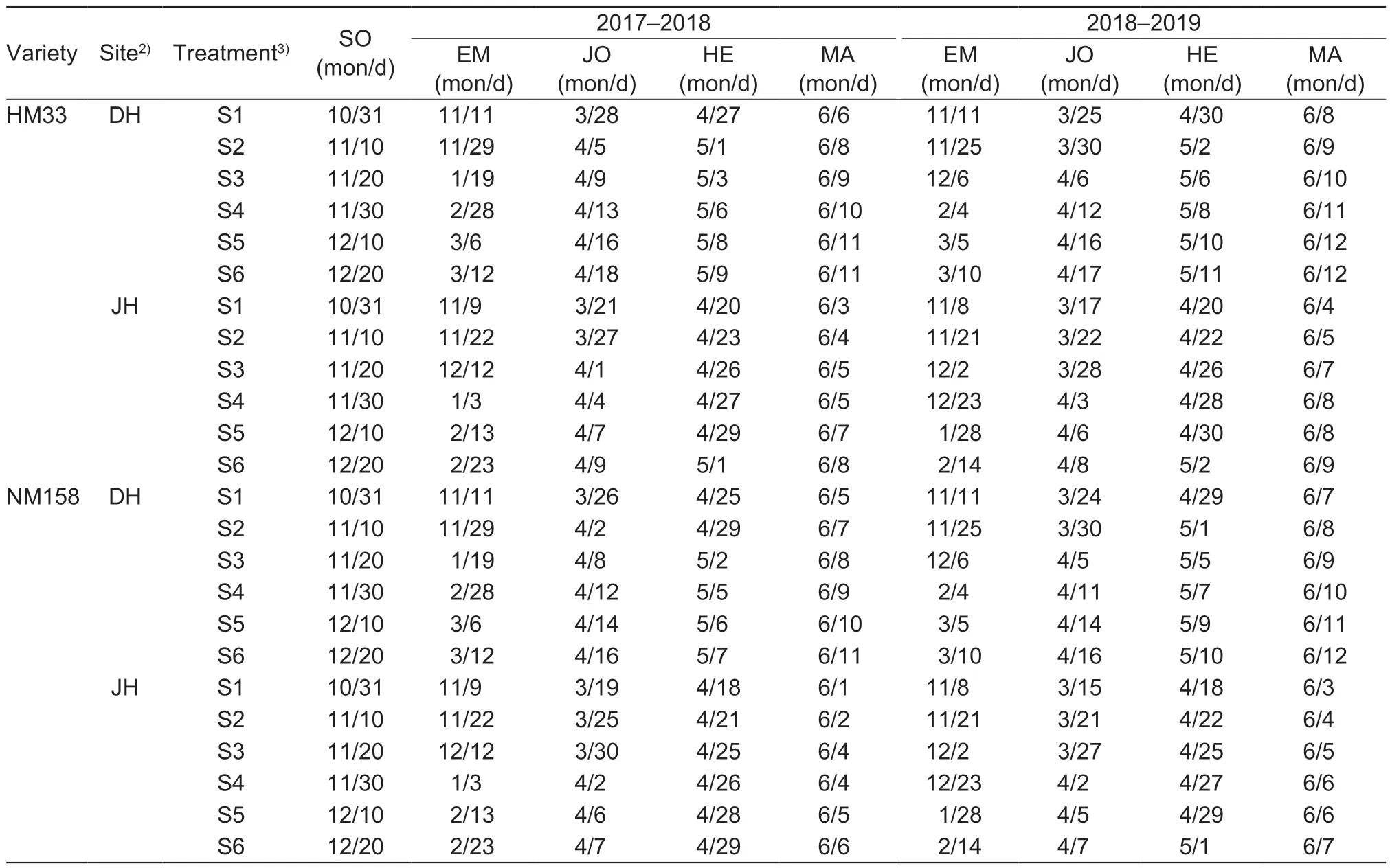
Table 1 Effects of sowing date and ecological points on the growth period of semi-winter wheat1)
3.2.Differences in the EAT and daily mean temperature (Tmean) of semi-winter wheat during the different growth periods by sowing date and ecological points
The changes in EAT of the two varieties showed the same rule for the sowing date and ecological point treatment, and the rule was similar in the different years (Fig.1).With a delay in the sowing date, the EAT of S1 was 72.8–358.6°C d higher than those of the other treatments.Other than the EAT from the sowing to seedling stage, which gradually increased with the sowing date, the EAT values of other growth stages gradually decreased.For a given sowing date, the EAT of DH during the whole growth period was –8.6–117.3°C d lower than that of JH.The EAT of DH from sowing to the emergence stage of wheat was 5.9–54.2°C d higher than that of JH.
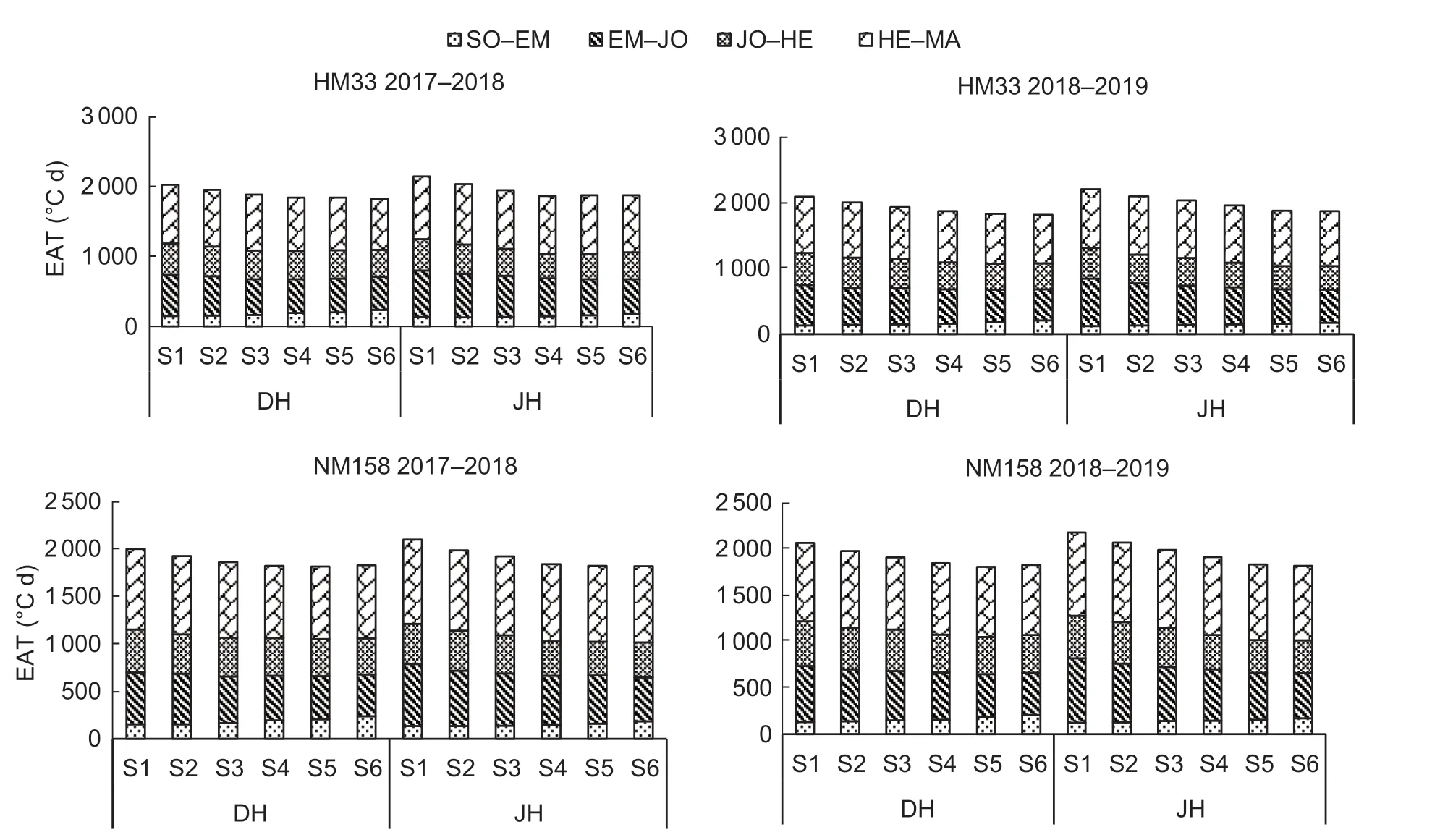
Fig.1 Effects of sowing date and ecological points on effective accumulative temperature (EAT) of wheat.SO–EM, sowing to emergence stage; EM–JO, emergence to jointing stage; JO–HE, jointing to heading stage; HE–MA, heading to maturity stage.DH, Donghai County, Lianyungang City, Jiangsu Province; JH, Jianhu County, Yancheng City, Jiangsu Province.S1–S6, October 31, November 10, November 20, November 30, December 10, and December 20, respectively.
The changes in Tmeanof the two varieties showed thesame rule with respect to sowing date and ecological point treatment, and the rule was similar in the different years (Fig.2).The Tmeanof the whole growth period increased gradually with the delay of the sowing date, while the Tmeanfrom sowing to the emergence stage decreased gradually with the delay of the sowing date.As the sowing date was delayed further, the Tmeanincreased gradually from the emergence stage to jointing stage, then to the heading stage and the mature stage.For a given sowing date, the Tmeanof DH during the whole growth period was 0.42–0.9°C higher than that of JH.The Tmeanfrom the emergence stage to jointing stage changed between treatments.The Tmeanvalues of S1 and S2 of DH were lower than those of JH, but the Tmeanvalues of S4, S5, and S6 for DH were higher than those of JH.
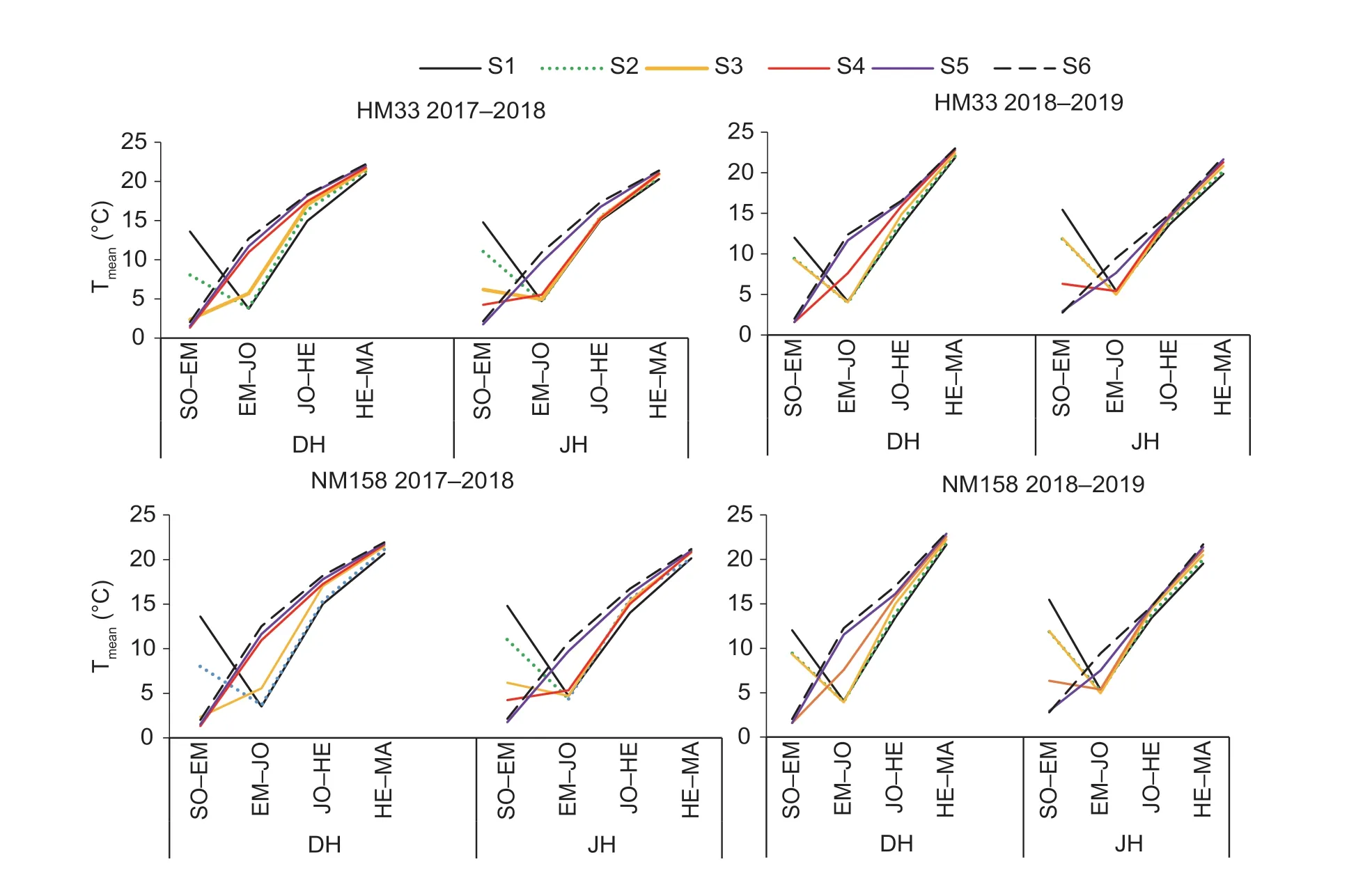
Fig.2 Effects of sowing date and ecological point on daily mean temperature (Tmean) of wheat.SO–EM, sowing to emergence stage; EM–JO, emergence to jointing stage; JO–HE, jointing to heading stage; HE–MA, heading to maturity stage.DH, Donghai County, Lianyungang City, Jiangsu Province; JH, Jianhu County, Yancheng City, Jiangsu Province.S1–S6, October 31, November 10, November 20, November 30, December 10, and December 20, respectively.
3.3.Differences of cumulative solar radiation (CSR) and daily mean radiation (Rmean) at the different growth stages of semi-winter wheat by sowing date and ecological points
For a given ecological point, the CSR of the whole growth period decreased gradually with the postponement of the sowing date (Fig.3).The CSR of S1 was 58–366 MJ m−2higher than those of S2–S6.The CSR of each growth stage from emergence to maturity decreased gradually with the postponement of the sowing date.For a given sowing date, the CSR of DH was 272–421 MJ m−2higher than that of JH for the whole growth period.The CSR of DH from JO to HE was 6–126 MJ m−2higher than that of JH.
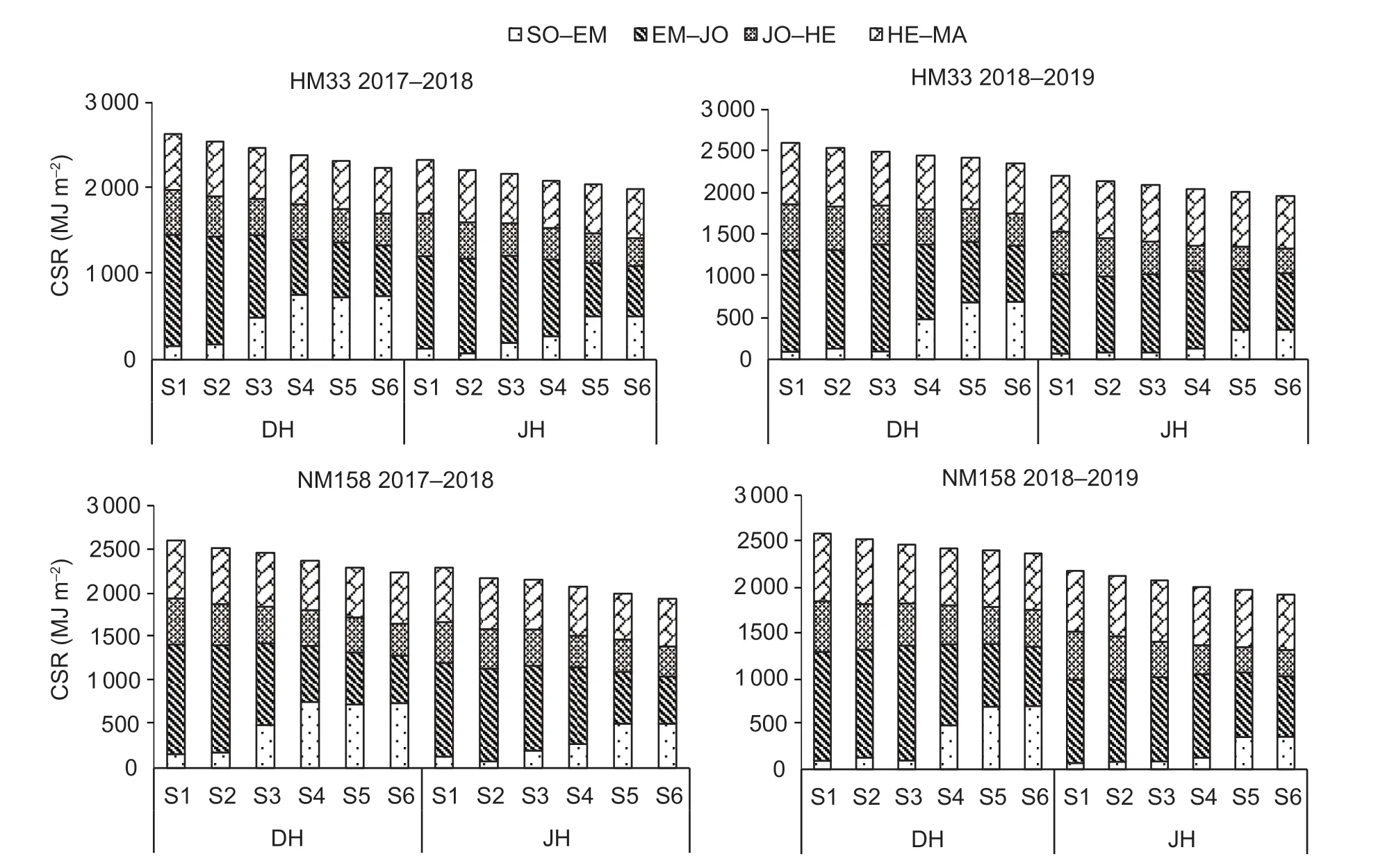
Fig.3 Effects of sowing date and ecological point on cumulative solar radiation (CSR).SO–EM, sowing to emergence stage; EM–JO, emergence to jointing stage; JO–HE, jointing to heading stage; HE–MA, heading to maturity stage.DH, Donghai County, Lianyungang City, Jiangsu Province; JH, Jianhu County, Yancheng City, Jiangsu Province.S1–S6, October 31, November 10, November 20, November 30, December 10, and December 20, respectively.
For a given ecological point, the Rmeanof the whole growth period decreased gradually with the postponement of the sowing date, and the Rmeanof S1 was 0.04–1.72 MJ m–2d–1higher than those of S2–S6 (Fig.4).The Rmeanof S1 from the emergence stage to jointing stage was 0.16–8.59 MJ m–2d–1lower than those of S2–S6.For a given sowing date, the Rmeanof DH was 1.24–2.19 MJ m–2d–1higher than that of JH during the whole growth period.The Rmeanof DH values from the emergence stage to jointing stage, and then to the heading stage and maturity stage were 1.05–6.64, 0–5.13, and 1.16–2.93 MJ m–2d–1higher than those of JH, respectively.

Fig.4 Effects of sowing date and ecological points on daily mean radiation (Rmean).SO–EM, sowing to emergence stage; EM–JO, emergence to jointing stage; JO–HE, jointing to heading stage; HE–MA, heading to maturity stage.DH, Donghai County, Lianyungang City, Jiangsu Province; JH, Jianhu County, Yancheng City, Jiangsu Province.S1–S6, October 31, November 10, November 20, November 30, December 10, and December 20, respectively.
3.4.Effects of sowing date and ecological point on the yield of semi-winter wheat and population dynamics
For a given ecological point, the yields of the two semiwinter wheat varieties decreased with the delay of sowing date, and the yield of S1 was 0.22–0.31, 0.5–0.78, 0.86–0.98, 1.14–1.38, and 1.36–1.59 t ha–1higher than those of S2–S6, respectively (Table 2).The analysis ofyield components showed that there was no significant difference in the number of wheat panicles with the change in the sowing date, but the number of grains per panicle and grain weight decreased with the delay of the sowing date.The number of grains per panicle of S1 was 0.43–1.91, 1.13–3.09, 2.51–3.95, 3.3–4.78, and 4.5–5.65 higher than those of S2–S6, respectively.The 1 000-grain weight of S1 was 0.58–1.49, 1.3–2, 2.1–3.76, 2.81–4.41, and 4.09–5.21 g higher than those of S2–S6, respectively.The main reason for the decline in yield was the decreases in the number of grains per panicle and 1 000-grain weight.For a given sowing date, the yield of DH was 0.01–0.4 t ha–1lower than that of JH.According to the analysis of yield structure, the average 1 000-grain weight of DH was 0.57 g less than that of JH.
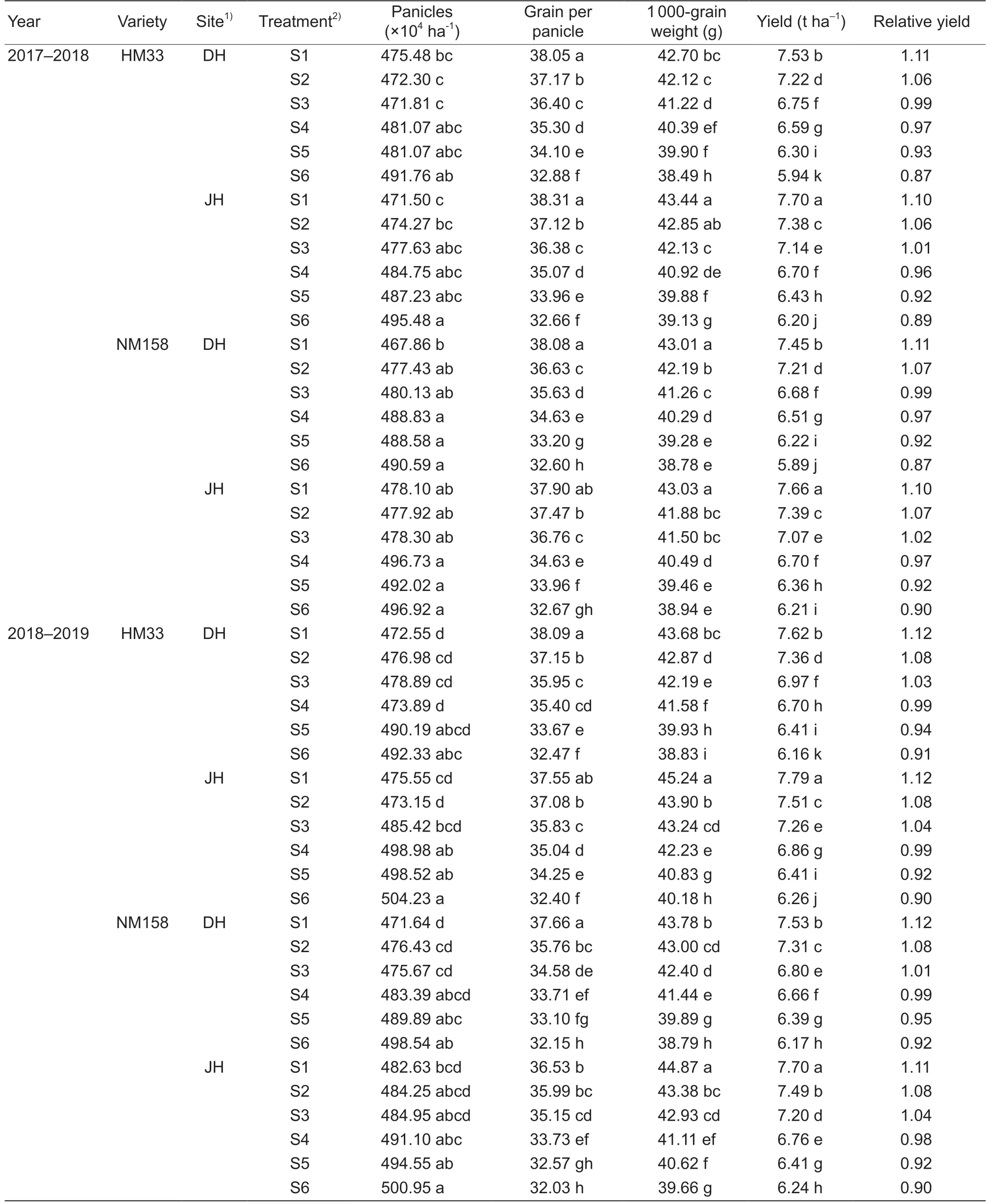
Table 2 Effects of sowing date and latitude on the yield of semi winter wheat
For a given ecological point, with the delay of the sowing date, the peak tiller number gradually decreased, and the ear bearing tiller rate gradually increased (Table 3).The number of peak tillers decreased by 87×104plants ha–1per delayed sowing date.For a given sowing date, the peak tiller number of DH was lower than that of JH, but the ear bearing tiller rate of DH was higher than that of JH.
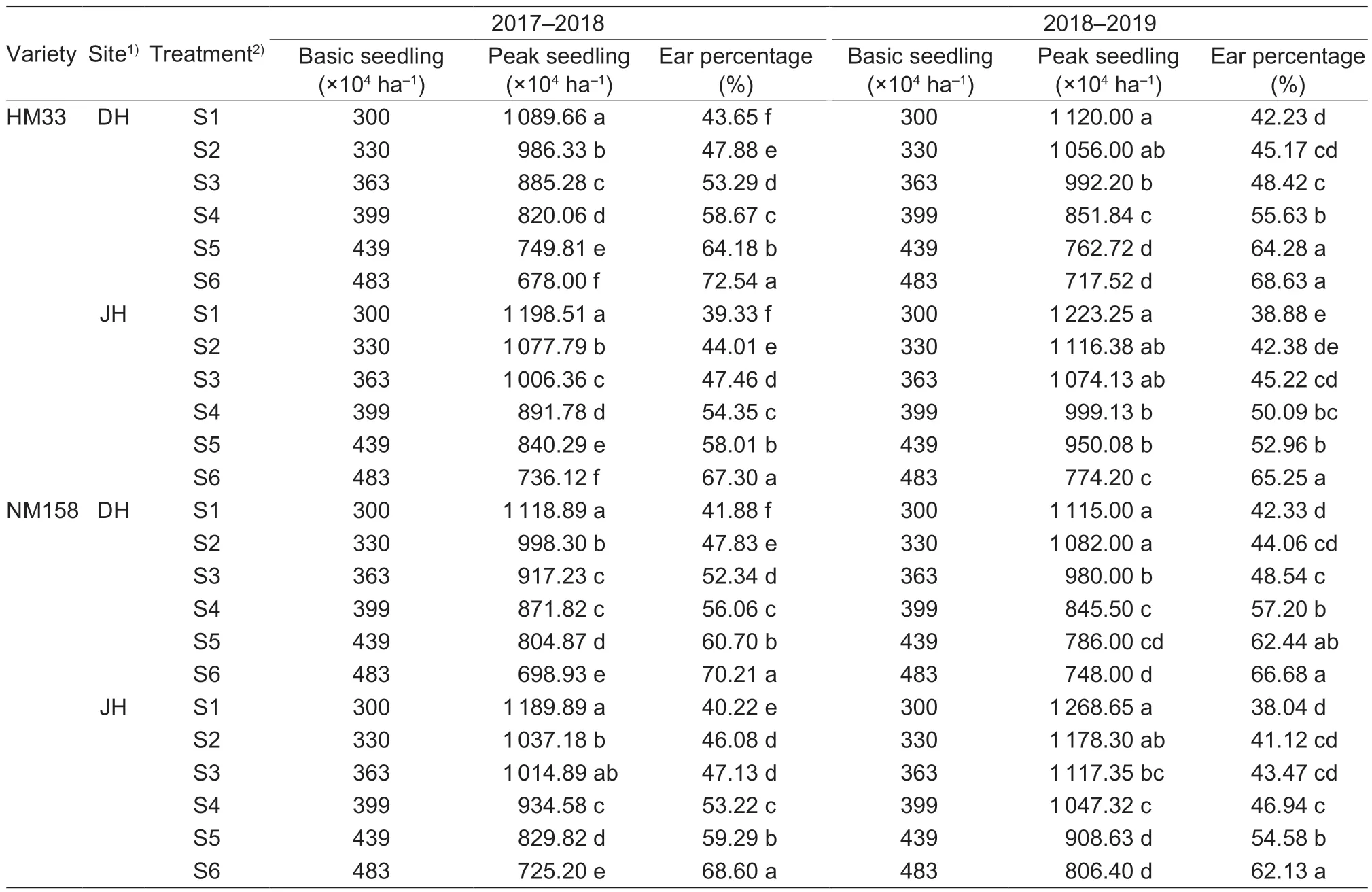
Table 3 Effects of different ecological sites and sowing dates on the population dynamics of wheat
3.5.Correlations of EAT, Tmean, CSR and Rmean with yield
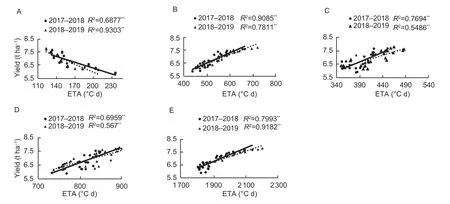
Fig.5 Correlations between effective accumulative temperature (EAT) and yield at the different stages.A–E, sowing to emergence stage, emergence to jointing stage, jointing to heading stage, heading to maturity stage, and the whole growth stage, respectively.**, significant difference at the level of 0.01.
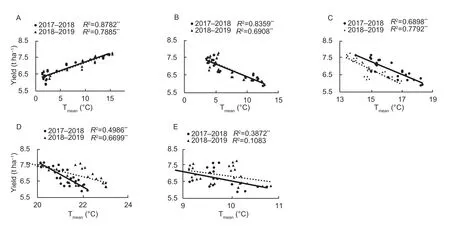
Fig.6 Correlations between daily mean temperature (Tmean) and yield at the different stages.A–E, sowing to emergence stage, emergence to jointing stage, jointing to heading stage, heading to maturity stage, and the whole growth stage, respectively.**, significant difference at the level of 0.01.
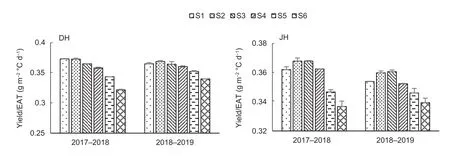
Fig.7 The ratios of yield to effective accumulative temperature (EAT) at the two sites in 2017–2018 and 2018–2019.S1–S6 represent the sowing dates of October 31, November 10, November 20, November 30, December 10 and December 20, respectively.DH, Donghai County, Lianyungang City, Jiangsu Province; JH, Jianhu County, Yancheng City, Jiangsu Province.The vertical bars represent the standard errors of the average values of the two varieties.
The correlation analysis of yield and radiation at the different ecological sites showed that there was a significantpositive correlation between yield and CSR, and an extremely significant negative correlation between yield and Rmean(Figs.8 and 9).There was a significant positive correlation between CSR and yield from the emergence stage to jointing stage, and a significant negative correlation between Rmeanand yield.There was a significant positive correlation between CSR and yield from JO to HE and from the heading to maturity stage.Yield/CSR reflected radiation production efficiency (Fig.10).The radiation production efficiency of DH decreased gradually with the delay of sowing time, while that of JH decreased gradually from S3 to S6.
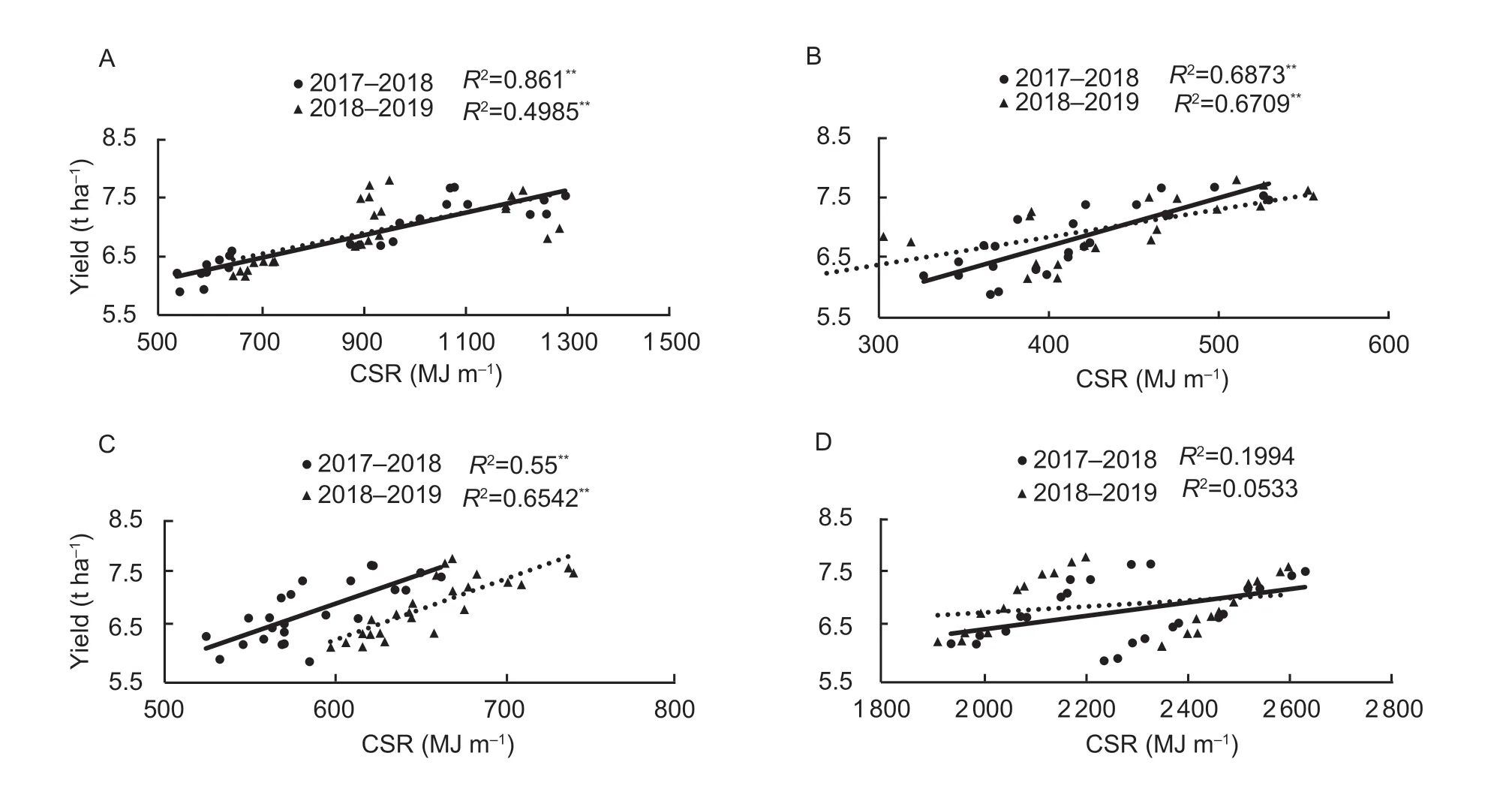
Fig.8 Correlations between cumulative solar radiation (CSR) at the different growth periods and yield of semi-winter wheat.A–D, emergence to jointing stage, jointing to heading stage, heading to maturity stage, and the whole growth stage, respectively.**, significant difference at the level of 0.01.
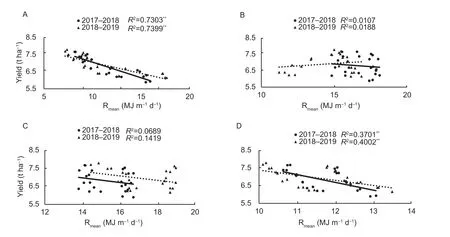
Fig.9 Correlations between daily mean radiation (Rmean) at the different growth periods and yield of semi-winter wheat.A–D, emergence to jointing stage, jointing to heading stage, heading to maturity stage, and the whole growth stage, respectively.**, significant difference at the level of 0.01.

Fig.10 The ratios of yield to cumulative solar radiation (CSR) at the two sites in 2017–2018 and 2018–2019.S1–S6 represent the sowing dates of October 31, November 10, November 20, November 30, December 10 and December 20, respectively.DH, Donghai County, Lianyungang City, Jiangsu Province; JH, Jianhu County, Yancheng City, Jiangsu Province.The vertical bars represent the standard errors of the average values of the two varieties.
4.Discussion
4.1.Changes in temperature and radiation resources of semi-winter wheat by sowing date and ecological points
The differences in sowing date and ecological points changed the temperature and radiation of the wheat growth period.The effective accumulative temperature and cumulative solar radiation decreased as the sowing date and the mature stage were delayed, while the growing days were shortened.Temperature and radiation directly affect the growth of wheat (Wanget al.2020).During the period from sowing to the emergence stage, the emergence stage was delayed due to the low temperature; and more effective accumulative temperature is needed for the growth of wheat (Li X Det al.2015; Lvet al.2017).A higher temperature and more radiation will accelerate the growth of wheat and the growth process of wheat, thus reducing the accumulated temperature and the accumulated solar radiation (Porterand Gawith 1999; Jeonget al.2018).In this study, for each delayed sowing date, the total growth days decreased by 8 days, and the effective accumulative temperature and the cumulative solar radiation decreased by 27.32–46.3°C d and 38.44–61.05 MJ m−2, respectively.From sowing to the emergence stage, the mean daily temperature decreased gradually as the sowing date was delayed, and the emergence time was prolonged; and in this case, the effective accumulative temperature was higher, at up to 237°C d.With the delay of the sowing date from the emergence stage to jointing stage, the daily temperature and solar radiation gradually increased.The increases in temperature and daily solar radiation accelerated the growth of wheat, and the maximum difference between S1 and S6 was 100 d.The effective accumulative temperature and growth days from jointing to heading and from heading to maturity decreased, although the decrease was not that great.
For each latitude change of the ecological points, the number of growing days of wheat decreased or increased by 3 to 4 days, and the average temperature of the whole growing period increased or decreased by 0.2°C (Williamset al.1971; Nie 2018).In this study, DH was one latitude interval higher than JH, and as a result, the growth period of DH was 3 to 5 days longer than JH, the average temperature of DH was 0.42–0.9°C lower than JH, and the effective accumulative temperature of DH was –8.6–117.3°C d lower than JH.However, the cumulative solar radiation of DH was 272–421 MJ m−2higher than that of JH.Compared with the other periods, the differences from sowing to the emergence stage and from the emergence stage to jointing stage were the greatest, and the difference between the average temperatures was the greatest.From the emergence stage to jointing stage, the effective accumulative temperature of DH was 21.3–107.1°C d less than that of JH, and this difference was the greatest compared with the other stages.
4.2.Formation of yield and yield components
The changes in sowing date and ecological points affected the formation of wheat yield (Quet al.2019).Previous studies showed that a delayed sowing date had effects on panicle number, panicle grain number, and grain weight (Yanet al.2008; Xiet al.2020).For each delayed sowing date in this study, the yield of semi-winter wheat, the panicle grain number, and the 1 000-grain weight decreased by 0.3 t ha–1, 1.06, and 0.92 g, respectively.Delaying the sowing date can reduce the occurrence of tiller number, and an increase in the number of basic seedlings can compensate for the difference in panicle number.As predicted by our preliminary experiment, there was no significant difference in panicle number among the different treatments when the number of basic seedlings was increased by 10%.Wheat yields increase with rising latitude (Xuet al.2021).The results obtained here are different, where the yield of DH was lower than that of JH because the uniform sowing time was controlled at the different ecological points in this experiment.This situation leads to decreases in the effective accumulative temperature and accumulated solar radiation during the growth period.
The yield of wheat is mainly composed of panicle number, grain number per panicle and 1 000-grain weight, and their formation is affected by temperature and radiation (Liuet al.2011).The shortage of spike numbers caused by reductions temperature and radiation was compensated by supplementing additional basic seedlings (Coventryet al.1993; Tianet al.2011; Liet al.2012).In this study, there was no significant difference in the number of panicles in the treatment of sowing date in conjunction with supplementing basic seedlings by 10% for each delayed sowing date.The normal temperature for spike differentiation is 12–17°C (Yang 2011).When the temperature is high, the time of spikelet differentiation is shortened with an increase in spikelet florets (Yang 2011; Shi and Shi 2016; Taoet al.2018).In this study, the temperatures of S3–S6 from JO–HE in DH were more than 17°C in the first year, and the average temperature of S6 was 2.59°C higher than that of S1.Therefore, the temperature of panicle differentiation increased gradually, which shortened the differentiation time and led to the decline of panicle differentiation quality.The spike differentiation temperatures of S3–S6 were higher than the appropriate spike differentiation temperature, which caused high temperature stress for spike differentiation and affected the quality and process of spike differentiation.The effective accumulative temperature and cumulative solar radiation from S1 to S6 decreased gradually, which could not meet the requirement of accumulated temperature for spike differentiation, leading to the decrease in grain number per spike.The suitable temperature for wheat filling is 18–22°C.When the temperature is too high, it accelerates wheat filling and plant senescence, but shortens the filling time, reduces the utilization of radiation by photosynthetic cells and decreases the 1 000-grain weight (Yang 2011; Shi and Shi 2016).In this study, the temperatures from heading to maturity of S3–S6 in the second year in DH were more than 22°C.The average temperature of S6 was 1.43°C higher than that of S1.The high temperature affected the formation of photosynthates in the grains.The effective accumulative temperature and cumulative radiation of S6 decreased, which lowered the energy of grain formation.Therefore, the formation of grain number per spike and 1 000-grain weight of wheat were affected by the delay of the sowing date, the increase in average temperature and the decreases in effective accumulative temperature and cumulative radiation, resulting in a decrease in yield.There was a great difference in cumulative radiation between the heading and ripening stages in the two-year experiment, which may be due to the combined effect of temperature and radiation.The higher temperature was accompanied by more solar radiation; and a high temperature would have a negative impact on plants, but the greater radiation would not be fully utilized (Denget al.2015).Therefore, solar radiation was not the main factor affecting the yield of semi-winter wheat compared with temperature.
4.3.Obtaining the latest safe sowing date for relatively high yield
Among the six different sowing dates in this study, the yields of semi-winter wheat for S1–S5 at the two ecological sites were higher than the average yield(6.4 t ha–1) in the north of Jiangsu (Xuet al.2021).Relative yields greater than 1 would be considered as high yields (Zhouet al.2021).The relative yields were more than 1 before the experimental delays in S2 of DH (November 10) and S3 of JH (November 20).The production efficiency of accumulated temperatures in DH and JH decreased gradually after S2 and S3, respectively.The radiation production efficiency decreased gradually after the ecological point of S2 in DH and JH.The sowing temperature was lower than 0°C for a long time, which affected the quality of seedling emergence.Previous studies have found that when the sowing temperature is below 0°C for a long time, the seedling emergence quality is affected (Bao 2002).At the experimental site S2 in DH (November 10) and the experimental site S3 in JH (November 20), the longest cycle below 0°C from sowing to seedling emergence lasted for 10 days, which did not have a great effect on seedling emergence.If sowing is too late, the effect of vernalization of semiwinter wheat (the temperature for the semi-winter wheat is 0–7°C, requiring 15 to 35 days) would be affected as the weather becomes warmer (Yang 2011; Kruseet al.2020).At the latest sowing time, the mean daily temperature was more than 53 days at 0–7°C, which can meet the requirements of vernalization.The average temperature of daily grain filling of wheat was more than 25°C, which can easily affect the grain filling of wheat (Liet al.2018).The maximum number of days when the mean daily temperature exceeded 25°C was 8 days, however, that would appear in the later stage of grain filling.Therefore, the high temperature stress was not that great.To sum up, sowing before the experimental site S2 in DH (November 10) and the experimental site S3 in JH (November 20) should be safe for harvesting, and a relatively high yield can be obtained in the case of supplementing with additional basic seedlings.
5.Conclusion
In this experiment, different sowing dates were set at different ecological points to explore the effects of sowing date and ecological points on the yield of semi-winter wheat, and the correlations among temperature, radiation, and yield.The changes in sowing date and ecological point caused changes in the temperature and radiation in the different growth stages of wheat.The increase in temperature, and the decreases in effective accumulated temperature and solar cumulative radiation led to decreases in grain number per ear and 1 000-grain weight, which then led to a decrease in semi-winter wheat yield.Under the condition of sowing before the experimental sites S2 (November 10) in DH and S3 (November 20) in JH and supplementing with additional basic seedlings, a higher yield can be obtained.
Acknowledgements
We are grateful for grants from the Jiangsu Demonstration Project of Modern Agricultural Machinery Equipment and Technology, China (NJ2020-58, NJ2019-33, NJ2021-63).
Declaration of competing interest
The authors declare that they have no conflict of interest.
杂志排行
Journal of Integrative Agriculture的其它文章
- Review on the fully mulched ridge–furrow system for sustainable maize production on the semi-arid Loess Plateau
- Development and characterization of a novel common wheat–Mexico Rye T1DL·1RS translocation line with stripe rust and powdery mildew resistance
- Revealing the process of storage protein rebalancing in high quality protein maize by proteomic and transcriptomic
- Association mapping of lignin response to Verticillium wilt through an eight-way MAGlC population in Upland cotton
- Dry matter production and panicle characteristics of high yield and good taste indica hybrid rice varieties
- Late sowing enhances lodging resistance of wheat plants by improving the biosynthesis and accumulation of lignin and cellulose
